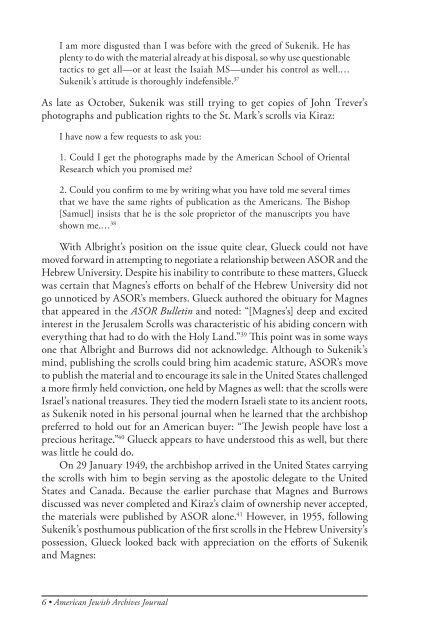The American Jewish Archives Journal, Volume LXI 2009, Number 1
The American Jewish Archives Journal, Volume LXI 2009, Number 1
The American Jewish Archives Journal, Volume LXI 2009, Number 1
Create successful ePaper yourself
Turn your PDF publications into a flip-book with our unique Google optimized e-Paper software.
I am more disgusted than I was before with the greed of Sukenik. He has<br />
plenty to do with the material already at his disposal, so why use questionable<br />
tactics to get all—or at least the Isaiah MS—under his control as well.…<br />
Sukenik’s attitude is thoroughly indefensible. 37<br />
As late as October, Sukenik was still trying to get copies of John Trever’s<br />
photographs and publication rights to the St. Mark’s scrolls via Kiraz:<br />
I have now a few requests to ask you:<br />
1. Could I get the photographs made by the <strong>American</strong> School of Oriental<br />
Research which you promised me?<br />
2. Could you confirm to me by writing what you have told me several times<br />
that we have the same rights of publication as the <strong>American</strong>s. <strong>The</strong> Bishop<br />
[Samuel] insists that he is the sole proprietor of the manuscripts you have<br />
shown me.… 38<br />
With Albright’s position on the issue quite clear, Glueck could not have<br />
moved forward in attempting to negotiate a relationship between ASOR and the<br />
Hebrew University. Despite his inability to contribute to these matters, Glueck<br />
was certain that Magnes’s efforts on behalf of the Hebrew University did not<br />
go unnoticed by ASOR’s members. Glueck authored the obituary for Magnes<br />
that appeared in the ASOR Bulletin and noted: “[Magnes’s] deep and excited<br />
interest in the Jerusalem Scrolls was characteristic of his abiding concern with<br />
everything that had to do with the Holy Land.” 39 This point was in some ways<br />
one that Albright and Burrows did not acknowledge. Although to Sukenik’s<br />
mind, publishing the scrolls could bring him academic stature, ASOR’s move<br />
to publish the material and to encourage its sale in the United States challenged<br />
a more firmly held conviction, one held by Magnes as well: that the scrolls were<br />
Israel’s national treasures. <strong>The</strong>y tied the modern Israeli state to its ancient roots,<br />
as Sukenik noted in his personal journal when he learned that the archbishop<br />
preferred to hold out for an <strong>American</strong> buyer: “<strong>The</strong> <strong>Jewish</strong> people have lost a<br />
precious heritage.” 40 Glueck appears to have understood this as well, but there<br />
was little he could do.<br />
On 29 January 1949, the archbishop arrived in the United States carrying<br />
the scrolls with him to begin serving as the apostolic delegate to the United<br />
States and Canada. Because the earlier purchase that Magnes and Burrows<br />
discussed was never completed and Kiraz’s claim of ownership never accepted,<br />
the materials were published by ASOR alone. 41 However, in 1955, following<br />
Sukenik’s posthumous publication of the first scrolls in the Hebrew University’s<br />
possession, Glueck looked back with appreciation on the efforts of Sukenik<br />
and Magnes:<br />
6 • <strong>American</strong> <strong>Jewish</strong> <strong>Archives</strong> <strong>Journal</strong>

















